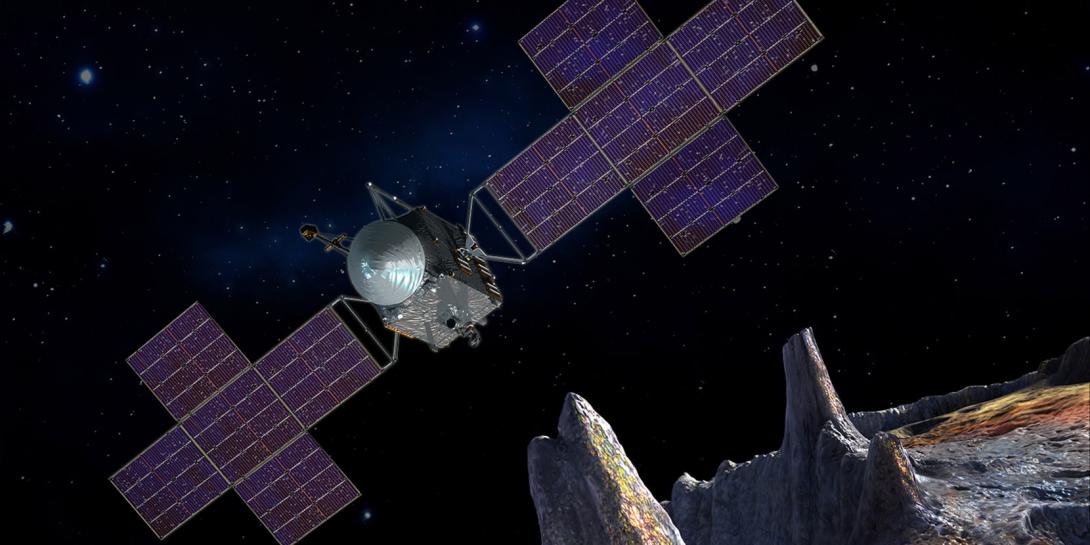NASA Counts Down to Laser Communications for Mars
In the coming months, researchers at NASA’s Jet Propulsion Laboratory expect to take a series of small steps that will ultimately result in a giant leap in laser-enabled Mars telecommunication capabilities. Their technological progress will contribute to a telecommunications infrastructure around the planet that will support both human and robotic expeditions.
Mars is expected to be a veritable hotbed of activity in the relatively near future. NASA’s InSight lander is scheduled to touch down in November to study the planet’s deep interior using seismology and various sensors. The planet also is drawing commercial interest. SpaceX plans to land its Red Dragon spacecraft in 2020.
Those systems will be joined in 2021 by NASA’s Mars 2020 Rover and by the ExoMars Rover, a European Space Agency vehicle.
Interest in Mars is only expected to heat up beyond 2021, and the flurry of activity—and the bandwidth needed to support it—could strain the aging network NASA uses to send data back to Earth. “Future human and robotic expeditions into deep space must count on the fastest, most efficient means of communicating with mission managers on Earth,” NASA officials say on the agency’s webpage for the Deep Space Optical Communications (DSOC) project. “A steady stream of high-definition imagery, live video feeds and real-time data transmission across the gulf of space will be required to enable timely guidance and mission-critical updates during the long-duration journeys to the far reaches of the solar system.”
DSOC is a pathfinder system that could be integral to setting up a telecommunications infrastructure around Mars, says Abhijit Biswas, DSOC project technologist at the Jet Propulsion Laboratory. “The architecture involves telecom orbiters around Mars that can cover the surface and continue to stream data down in preparation for more activity on Mars, eventually leading to human activity. If our technology demonstration is successful, I think our contribution to that architecture will be significant,” Biswas predicts.
The applied research project is now in the implementation phase. DSOC’s laser communications are considered emerging technology that promises some major advantages over traditional radio-frequency communications. “The main benefit is that the laser beams are much narrower than your radio-frequency beams, so you can get more energy density at the target. The amount of information that you can transmit for a second, the megabits per second, goes up the more power density you have at the receiver. You get a big boost in data rates,” Biswas says.
Furthermore, the radio-frequency spectrum on Earth has become quite crowded with the seemingly insatiable appetite for cellphones, social media and videos. “The demand keeps growing every day, so there’s bandwidth congestion in the radio-frequency region of the spectrum. By going to lasers, you’re going to relax that because you’ve got lots of free spectrum with the laser wavelengths,” Biswas adds.
In theory, the system could provide anywhere from five to 50 times the data rates of current state-of-the-art systems without increasing size, weight and power requirements. NASA’s Technology Roadmaps, which guide the agency’s development of space technologies, ultimately seek to improve communications performance 10 to 100 times.
After design reviews of the payload—a preliminary one this fall and a critical one next summer—the DSOC payload is scheduled to launch in 2022 aboard NASA’s robotic Psyche mission. The journey will help scientists understand the metal asteroid known as 16 Psyche, one of the most massive rocks floating around the asteroid belt. Aided by a Mars gravity assist in 2023, the Psyche spacecraft will reach its destination in 2026, when the DSOC payload is expected to help transmit information obtained from the expedition into the solar system more clearly and quickly than ever.
Assuming all goes well, the technology demonstration project will dramatically increase the distance for reliably communicating with a laser system. Previous demonstrations from the moon to Earth—an average distance of about 240,000 miles—have been successful. “We’ve already got a few laser comm demonstrations under our belt, but the thing DSOC is going to try to do is take it farther—all the way to Mars distances,” Biswas notes. Mars is approximately 140 million miles from Earth, on average.
Communicating from Mars presents some obstacles. “The main challenge of beam communications is that you have a very narrow beam. It’s the same narrow beam that gives you the high power density, but because it’s so narrow, you have to point it very carefully,” he states.
The system will have to operate in ways that present additional challenges. At times, it will be oriented away from the sun and, at other times, not so much. That will require a system capable of handling dramatic temperature swings. “When you’re looking close to the sun, everything heats up, and when you’re looking away from the sun, everything cools down, so you have to be able to design a system that can have a dynamic range,” Biswas elaborates.
Because DSOC is an optical system communicating via light, the sun can interfere as well. “It’s just like when you’re driving and a windshield gets very dusty, and it can be blinding. The same thing happens with the sensors,” he states. “We have to maintain a certain level of cleanliness when we point close to the sun, and we have to be able to detect our signal of interest in the presence of background noise.”
Furthermore, the necessity for finely tuned accuracy can be difficult from deep space. “If the spacecraft is vibrating, you have to suppress that vibration. If the spacecraft is moving around in some deadband cycle, then you have to compensate for that and hold your beam locked to some target,” Biswas says. “Not only do you have to be able to point very accurately, but you also have to compensate for all those effects on the platform.”
Recent technological breakthroughs seem to be meeting those challenges. “Most of the advances have been in that area, but that uses lasers; that uses actuators; that uses detectors. All of those component-level technologies have had to advance to enable the main objective: to point a very narrow laser beam very accurately,” Biswas remarks.
The system is being evaluated as much as possible in the lab, but the real test will come once it is launched into space and exposed to every one of the extreme elements in a deep space environment. Replicating all those conditions on the ground would likely be prohibitively expensive.
NASA’s website says DSOC will deliver a flight-ready deep space optical transceiver and ground data system. DSOC will employ novel advanced lasers in the near-infrared region of the electromagnetic spectrum. Key technologies developed for the project include a low-mass spacecraft disturbance isolation and pointing assembly; a high-efficiency flight laser transmitter; and a pair of high-efficiency photon-counting detector arrays for the flight optical transceiver and the ground-based receiver. These technologies are integrated into the DSOC flight laser transceiver and ground-based receiver to enable photon-efficient communications with the capability to discern faint laser signals from solar energy-related background noise.
L3 SSG is building the optics that essentially help point the beam. LGS Innovations is the contractor for the flight laser, and Controlled Dynamics is responsible for some of the isolation systems that dampen vibrations and lock the laser on target.
The 2022 system launch will offer lessons learned so that the technology can be tweaked in the years to come. The timing for the fielding of a fully operational system may depend on whom you ask, according to Biswas, but he suggests that the next decade should be promising. “We will be able to deploy systems much sooner than that, but they will still go through some evolution before they are fully operational,” he says.
He also forecasts that the research could offer benefits right here on the home planet, potentially for biomedical optics and spectroscopy, as well as for military satellite communications.






Comments